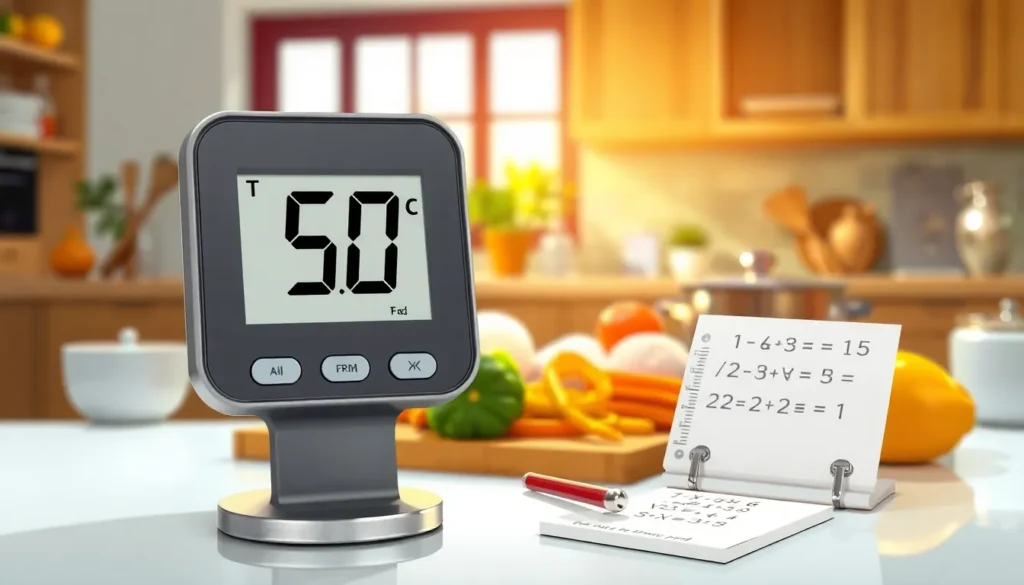Ever found yourself scratching your head over temperature conversions? It’s like trying to solve a Rubik’s cube blindfolded. But fear not! Converting 50 degrees Fahrenheit to Celsius is easier than finding a cat video on the internet.
Table of Contents
ToggleUnderstanding Temperature Conversion
Temperature conversion plays a crucial role in daily activities, such as cooking and weather forecasting. To convert degrees Fahrenheit to degrees Celsius, use the formula:
[ C = frac{(F – 32) times 5}{9} ]
This formula simplifies the conversion process. For example, applying this formula to 50 degrees Fahrenheit yields approximately 10 degrees Celsius.
Many people encounter Fahrenheit and Celsius in different contexts. In the United States, Fahrenheit remains common for weather and cooking temperatures. Conversely, most countries utilize Celsius as a standard. Understanding both scales can enhance global communication and comprehension of temperature data.
Precision matters when discussing scientific research and weather reports. Knowing how to convert specific temperatures allows for accurate interpretations. Notably, the water freezing point stands at 32 degrees Fahrenheit or 0 degrees Celsius. Therefore, recognizing these benchmarks aids in understanding everyday temperatures.
Transforming measurements eases planning for outdoor activities, travel, and cooking. When preparing meals, for example, knowing the temperature range in both Fahrenheit and Celsius can ensure consistent results.
Thermometers typically display Celsius or Fahrenheit, depending on the region. Users may switch between the two units for convenience. Many digital devices also feature a quick conversion option, simplifying the process when needed.
Ultimately, mastering temperature conversion fosters better understanding across different measurement systems. Whether checking the weather or following recipes, being familiar with converting degrees enhances everyday life.
The Formula for Conversion


Understanding temperature conversion starts with knowing the correct formulas. The formula for converting Fahrenheit to Celsius is crucial.
Fahrenheit to Celsius Equation
The equation for this conversion is C = (F – 32) × 5/9. Plugging in 50 degrees Fahrenheit into the formula illustrates the process. After subtracting 32 from 50, the result is 18. Then, multiplying by 5/9 leads to approximately 10 degrees Celsius. This equation serves as a reliable reference point for numerous temperature conversion scenarios.
Celsius to Fahrenheit Equation
To reverse the process, use the equation F = (C × 9/5) + 32. This formula allows for quick conversion from Celsius back to Fahrenheit. For example, if starting with 10 degrees Celsius, multiply by 9/5, which results in 18. Adding 32 yields 50 degrees Fahrenheit. Mastering both equations provides flexibility in navigating temperature measurements across various contexts.
Example Conversion: 50 Degrees F to C
Converting 50 degrees Fahrenheit to Celsius requires a straightforward calculation that enhances everyday understanding of temperature measurements.
Step-by-Step Calculation
First, take the Fahrenheit temperature of 50 degrees. Then, subtract 32 from this number, resulting in 18. Next, multiply 18 by 5. After that, divide the result by 9, yielding approximately 10 degrees Celsius. This step-by-step approach demonstrates how simple the conversion process can be. Each part of the formula contributes to a clear understanding of temperature differences.
Practical Applications of the Conversion
Understanding this conversion benefits various daily activities. Weather forecasts often feature both Celsius and Fahrenheit, allowing for broader comprehension. Cooking recipes may require temperature adjustments across different measurement systems. Additionally, planning outdoor events can depend on precise temperature readings. Travelers gain from knowing temperatures in both systems, enhancing their overall experience. Mastering temperature conversions empowers individuals in countless situations, facilitating communication and comprehension.
Common Temperature Conversion Challenges
Converting temperatures between Fahrenheit and Celsius often creates confusion. Factors such as different scaling points contribute to the complexity. Many people forget that the freezing point for water is 32 degrees Fahrenheit, or 0 degrees Celsius. Relying solely on intuition can lead to inaccuracies in real-world applications.
Common errors arise when people overlook the required mathematical operations in conversion formulas. Understanding how to apply the formula is essential: for Fahrenheit to Celsius, use C = (F – 32) × 5/9. Misapplication of this formula frequently results in incorrect temperature assessments, particularly in professional settings.
Reversing the process poses its own challenges. For instance, when converting Celsius back to Fahrenheit using F = (C × 9/5) + 32, it’s easy to miscalculate. Many individuals mistakenly apply the wrong operations or neglect to account for both multiplication and addition in the sequence.
Thermometers present additional obstacles, as some display only one scale. Users can struggle to interpret measurements without understanding how to make quick conversions. Many digital devices offer conversion features, yet not all are intuitive, making it important for users to familiarize themselves with these tools.
Daily activities, such as cooking or planning outdoor events, depend on accurate temperature conversions. Misunderstandings in temperature readings can lead to unexpected results, impacting everything from culinary success to weather preparedness. Understanding both systems is crucial for effective communication in global contexts.





